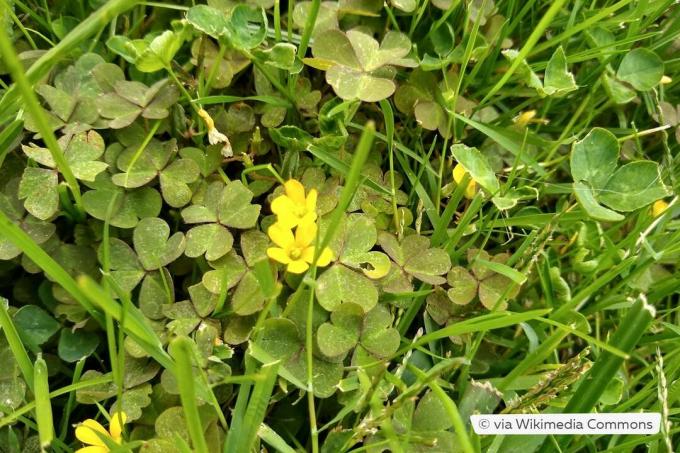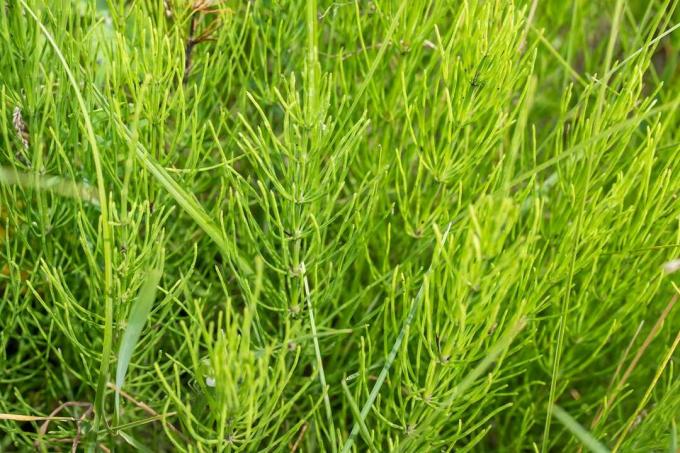
A lack of lime leads to acidification of the soil, which means that unwanted plants can grow in the lawn. Persistent lack of lime can cause lasting damage to the lawn, which is why you should react at the first sign.
In a nutshell
- pay attention to indicator plants such as farmer's mustard, Hasenklee or lesser sorrel
- Determine soil pH with test kit
- determine the pH value separately for problem areas
- Determine the soil pH regularly until summer
- do not lime or water the lawn during dry periods
Table of contents
- pointer plants
- soil analysis
- Carrying out a soil analysis:
- frequently asked Questions
pointer plants
Indicator plants are a first indication that something is wrong with the lawn. The weeds have the unpleasant side effect that they usually have a large basal leaf rosette and thus additionally displace the lawn grass.

The following weeds in the lawn indicate a lack of lime:
- peasant mustard (Teesdalia nudicaulis)
- rabbit clover (Trifolium arvense)
- Three Leaf Prize (Veronica triphyllos)
- dog chamomile (anthemis)
- Little sorrel (Rumex acetosella)
- Sand Pansies (Viola tricolor)
- field horsetail (Equisetum arvense)
A notice: That increased Occurrence of mosses and fungi in the lawn is rarely due to a lack of lime. Predominant is a compaction of the soil, which increases the moisture content as well as much thatch the cause of it.

Should you in your Turf other clover species, than the Hasenklee, then this is a sign of an alkaline soil. Additional lime doses could even promote the spread of the clover.
soil analysis
The indicator plants are a first sign that something is wrong with the soil pH value. Basically, a light sandy soil should have a pH of 5.5. If the soil is heavy and loamy, the value should be in the range of 6.5.
Since the indicator plants are an indication of acidification, but no exact pH value can be derived from them, you should always carry out a soil analysis before liming. You do not have to send any soil samples to the laboratory, you can buy the test kits inexpensively in stores.
Carrying out a soil analysis:
- Take soil samples from different places in the lawn
- sample conspicuous problem areas separately
- Mix soil samples and add test liquid
- Hold the test strip in the sample
- wait a moment until the color appears on the test strip
- Compare the pH value with the scale
A notice: Instead of test strips, there are also powders that are added to the soil sample. The soil sample then changes color and the color is again compared with the scale.

After determining the pH, you can calculate the exact amount of lime per square meter to cover the soil desired pH to reach. Carry out soil samples at intervals of three to four weeks until late spring so that you can add lime if necessary. This is necessary, for example, in persistent rainy weather, since in this case the lime is dissolved too quickly and reaches layers that the roots can no longer reach.
By the summer, the soil should optimal pH value achieved. You should avoid applying lime in the summer, as this is no longer dissolved as well due to the lower rainfall. Heat and drought can even damage the lawn if you spread lime. When applying lime in spring, it is optimal if one or two days of rain are announced afterwards. If it is dry for a long time, you should water the lawn in the spring so that the limescale dissolves and becomes available for the grass.
frequently asked Questions
The ideal time to whitewash the lawn is early spring. Carry out care measures such as scarifying the lawn and then spread lime on it. Please note, however, that there should be at least eight weeks between the application of lime and the next fertilization. The lawn should therefore be limed as early as possible in the year.
The amount of lime required depends on the composition of the soil or soil. the lime requirement. If there is an acute lack of lime and the soil is clearly too acidic, you can spread 10 - 20% more lime per square meter. On average, 100 grams of lime are spread per square meter.
Lawn sand is sand made from limestone or quartz rock. It is not sufficient as a source of lime, as it takes too long for the lime to dissolve. In addition, the amount of dissolved lime would not be sufficient in the event of an acute lack of lime. Quartz sand, on the other hand, contains no lime. Lawn sand is mainly used to improve the soil structure and is not a sustainable source of lime.



